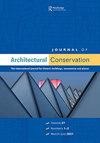The Ship of Theseus: a misleading paradox? The authenticity of wooden built heritage in Japanese conservation practice
IF 1
3区 艺术学
0 ARCHITECTURE
引用次数: 0
Abstract
ABSTRACT The conservation process of Japanese wooden buildings has often been likened to the Ship of Theseus, whose planks were gradually replaced until its material was completely renewed. This analogy suggests that the primary aim of Japanese conservation is retaining the original form, giving little consideration to material authenticity. However, an in-depth analysis of Japanese conservation practice reveals that this comparison is misleading. An examination of the ratios of remaining original material and its distribution in the building shows that historically, replacements were carried out in a limited manner, and complete renovation of the material did not take place. Instead, timbers in the ‘core’ part of the structure remain for the most part original, while timbers in the ‘periphery’ can be replaced several times. In addition, a review of guidelines for the conservation of heritage buildings in Japan shows that retaining ‘as much as possible of the old material’ was considered a fundamental principle from the beginning of modern heritage conservation. Finally, a survey of repair sites shows how this principle is rigorously observed in contemporary practice. As a result of this analysis, it becomes clear that conservation of material authenticity is, in fact, a fundamental concept in the Japanese approach.忒修斯之船:一个误导人的悖论?日本保护实践中木质建筑遗产的真实性
摘要日本木制建筑的保护过程经常被比作忒修斯之船,其木板逐渐被替换,直到材料完全更新。这种类比表明,日本保护的主要目的是保留原始形式,很少考虑材料的真实性。然而,对日本保护实践的深入分析表明,这种比较具有误导性。对剩余原始材料的比例及其在建筑中的分布进行的检查表明,从历史上看,更换是以有限的方式进行的,并且没有对材料进行全面翻新。相反,结构“核心”部分的木材大部分保持原样,而“外围”的木材可以多次更换。此外,对日本遗产建筑保护指南的审查表明,从现代遗产保护开始,“尽可能多地保留旧材料”就被视为一项基本原则。最后,对维修现场的调查表明,这一原则在当代实践中是如何得到严格遵守的。通过这一分析,很明显,保护材料的真实性实际上是日本方法中的一个基本概念。
本文章由计算机程序翻译,如有差异,请以英文原文为准。
求助全文
约1分钟内获得全文
求助全文

 求助内容:
求助内容: 应助结果提醒方式:
应助结果提醒方式:


